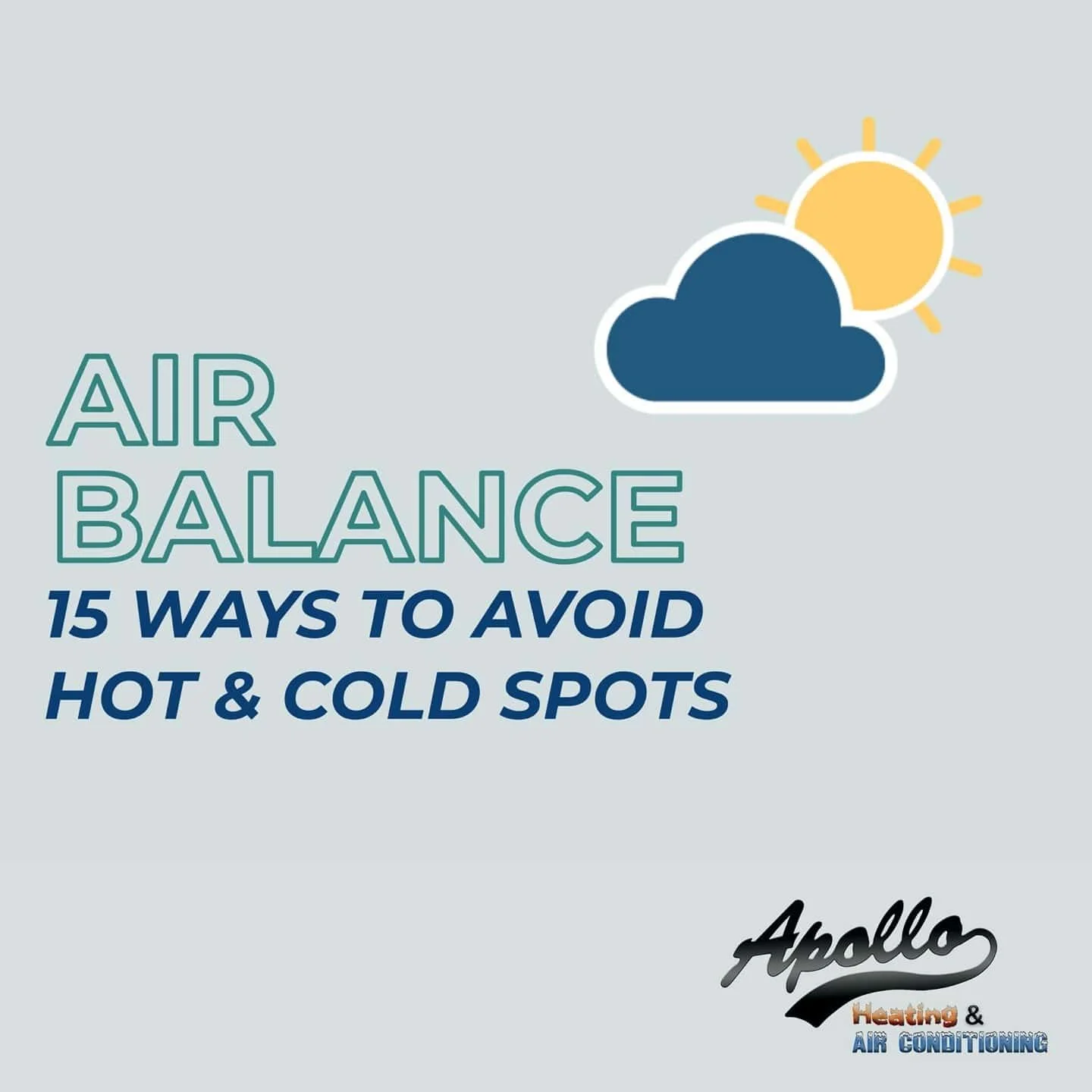If your HVAC system’s efficiency is on the decline, you might be concerned that there’s a serious problem with your home’s air temperature. After it’s looked into by an HVAC professional from Apollo Heating and Air Conditioning, you may be pleased to learn that it’s due to unbalanced system airflow. Air balancing your HVAC system can frequently restore its efficiency, and resolve other related issues like high energy bills, unnecessary wear on key components, and temperature inconsistencies.
What’s more, air balancing will improve your air circulation, increase energy efficiency, and enhance the general performance of your air conditioning and heating system. For you, as a homeowner, this translates into delivering the correct amount of air (hot or cold) to each room in your house, providing more comfortable air temperatures throughout your home.
Air balancing involves an expert technician at Apollo Heating and Air Conditioning testing and adjusting your system. They will examine your intake and output and modify as necessary.
According to Rob Falke, president of the National Comfort Institute, an HVAC-based training company, “balancing is the single-most important step that can be taken to assure your systems produce comfort and operate efficiently.”
Air balancing encompasses modifying your existing HVAC system to ensure the air is evenly distributed throughout your home. Every zone should have the appropriate amount of heat transfer. In short, all components of your HVAC system should work in harmony.
15 Tips on Balancing the Air Temperatures in Your Home
You want to avoid annoying hot and cold spots that can disrupt your comfort level in your home. Here are some easy steps you can take to make sure your HVAC system operates with the proper air balance:
1. Close or Open Your Register
You can move the damper blade as it will restrict airflow in the room. However, don’t completely close the vents, or it can cause other problems with your HVAC system.
During warm weather air temperature, open registers on your upper floor and partially close registers on your downstairs floor and/or your basement. When it’s cold, reverse the process.
2. Try a 2-Degree Offset
If you live in a two-story home and have two thermostats, program the temperatures so that they have a 2-degree off-set. In other words, set the thermostat at a 2-degree difference for the floors. For instance, upstairs might be set at 74 degrees and downstairs is at 72 degrees. This will make things better when it comes to minimizing or eliminating uneven air temperature.
3. Check Filters for Cleanliness
There are several important reasons to maintain clean filters:
Improves your air quality – cleaning the debris that accumulates on your filters will assist with airflow.
Increases the efficiency of your furnace – reduced airflow through your heating and cooling system may cause your heat exchange to overheat and shut off too quickly. So, make sure the filter is clean and it will maximize the efficiency of your furnace.
Extend the life of your HVAC system – the most common reason an HVAC system falters is because of a dirty filter. A dirt filter forces your system to work harder, causing it to overheat.
Help keep energy costs down by maintaining air temperature – heating your house uses more energy and is more expensive than any other HVAC function in your house. It typically makes up about 42 percent of your utility bill. Your system runs more efficiently when it is clean. This will give you energy and monetary savings. In fact, if you regularly change your filter, you could save 5 percent to
15 percent on your energy bills.
4. Install Window Coverings to Prevent Heat
Window coverings do make a big difference in the overall comfort level of your home. They also help you save on your energy bills. During cool seasons, approximately 76 percent of the sunlight that falls on standard double-pane windows enters to become heat.
5. Avoid Placing Electronic Equipment Near A Thermostat
Electronic equipment generates a great deal of heat and can impact your comfort level. And with large screen TVs and computers, the distribution of heat in the room can change and may require modifications to your vents.
6. Check for Drafts
Make sure your windows and doors are sealed properly as these typically can cause cold spots in your home.
7. Adjust Ceiling Fans
When you change the directional settings of a fan, that can have a significant impact on your air circulation. Your ceiling fans should move counterclockwise during warmer months to generate cool downward airflow. However, it should be set to a lower speed in a clockwise motion during cooler seasons so it can evenly distribute warm air.
8. Prevent Airflow Restrictions
You will restrict airflow if you cover registers with furniture or other items. When you obscure a vent with furniture your system works much harder. Vents are designed to supply a free flow of air.
In fact, vents need at least 18 inches of space. Rearrange furniture and hem your curtains so you can enjoy ample airflow. You can even get a magnetic air deflector so that the air blows away from the nearby furniture.
9. Place Thermostat Fan Setting to “ON”
Your fan setting affects the quality of air in your home, as well as the comfort level. Typically, systems have two fan settings, On and Auto.
When you set your fan to the “ON” setting, the fan will blow continuously which will filter and always be replacing your indoor air. As a result, this will keep the air quality consistent. When you use the “Auto” position, air can become more stagnant.
10. Fix Your Duct Work
Repair ductwork damage or defects. If you don’t, you could experience uneven air distribution.
If the duct airflow is out of balance when you are attempting to heat your house, some rooms will not be warm enough while others are too cool. When you use the air conditioner, you could similarly have some rooms not cool enough and other rooms too warm.
You’re advised to call your local HVAC professional at Apollo Heating and Air Conditioning to repair your ducts.
11. Check Your Insulation
If you suspect your home is not properly insulated, or you do not have insulation, hire a professional to do an evaluation.
12. Check and Adjust Your HVAC System’s Blower Fan Speed
Here are steps you can take to adjust your system’s fan speed:
- Disconnect the power
- Locate the blower motor and wiring
- Identify the speed wires
- Change the active speed wire
- Test your HVAC system
13. Install Extra Return Ducts If Necessary
A second return duct can lower static pressure if the airflow bottleneck is on the return side.
14. Use Two Air Handlers
If a single air handler is used for heating and cooling, a basement located air handler will have an easier time sending warm air up onto the higher floors of a house than it will funneling cool air up into the same spaces during cool weather.
Note: Warm air rises in a building through convection, while heavier cool air tends to fall.
Try increasing the fan speed for cooling operation or booster fans could help. In order to avoid this problem altogether, some HVAC designs use two air handlers, placing the second unit in the attic or ceiling above the uppermost floor.
15. Know the Size of Your HVAC System
Be sure the size of your HVAC system matches the size of your home. This will help you avoid having a system that is too small or too large, as that could over condition your living spaces. When the furnace is too large, it can cause issues in your home – from short cycling to inefficient operation, to an uncomfortable living space.
Getting the correct size of a furnace should be left up to an HVAC professional at Apollo Heating and Air Conditioning. One of our expert technicians will perform a whole-house evaluation and then be able to recommend the right furnace size.
Improve Your Air Temperature Quality & Comfort with Apollo Heating and Air Conditioning
At Apollo, we are committed to keeping your air, and your home, perfectly comfortable. We do this, in part, by offering products that are designed to clean and purify indoor air.
Learn more by contacting Apollo Heating and Air Conditioning! Call us at (509) 396-COLD (2653).




